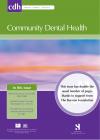Community Dental Health

- Cover Date:
- March 2011
- Print ISSN:
- 0265 539X
- Vol:
- 28
- Issue:
- 1
The prevalence of and risk factors for non-carious cervical lesions in adults in Hubei Province, China
Objectives: To describe the prevalence of non-carious cervical lesions (NCCLs) and to assess the relative affects of risk factors on NCCLs in middle-aged and elderly people in Hubei Province, China. Design: A sample of 2,160 adults, aged 35-44 years and 65-74 years and balanced by age, gender, and urbanization, participated in the cross sectional epidemiological survey. Non-carious cervical lesions were examined using a modified Tooth Wear Index. Data were collected based on structured questionnaires that assessed general information as well as oral health. Results: The prevalence of non-carious cervical lesions was 38.8% for 35-44-year-olds and 56.6% for 65-74-year-olds. The first premolars, canines, and second premolars showed the highest prevalence of lesions, while the second molars demonstrated the least. Several risk factors such as age (OR=2.45, p<0.001), location (OR=1.68, p=0.001), frequency of toothbrushing (OR=1.33, p=0.016), bruxism (OR=1.37, p<0.001), and family income (OR=1.44, p<0.001) were found to be associated with lesion occurrence. Conclusions: The prevalence of non-carious cervical lesions was relatively high in the middle-aged and elderly persons in China and was also associated with socio-behavioural risk factors.
Key words: China, non-carious cervical lesions, prevalence, risk factors
- Article Price
- £15.00
- Institution Article Price
- £0.00
- Page Start
- 22
- Page End
- 28
- Authors
- B.J. Tai, Z. Bian, B. Peng, W. Huang, M.Q. Du, H. Jiang
Articles from this issue
- Title
- Pg. Start
- Pg. End
- The caries experience of 5 year-old children in Scotland, Wales and England in 2007-2008 and the impact of consent arrangements. Reports of co-ordinated surveys using BASCD criteria
- 5
- 11
- The dilemma of selecting suitable proximal carious lesions in primary molars for restoration using ART technique.
- 12
- 16
- Using laser fluorescence (DIAGNOdent) in surveys for the detection of noncavitated occlusal dentine caries
- 17
- 21
- The prevalence of and risk factors for non-carious cervical lesions in adults in Hubei Province, China
- 22
- 28
- Health-related lifestyle behaviours, socio-demographic characteristics and use of dental health services in Greek adults.
- 47
- 52
- Periodontal health and treatment needs among hospitalized chronic psychiatric patients in Istanbul, Turkey
- 69
- 74
- Comparison of the COHIP and OHIP- 14 as measures of the oral health-related quality of life of adolescents
- 82
- 88
- Assessment and comparison of periodontal status among young smokers and nonsmokers of Bangalore, India - a cross sectional study.
- 89
- 94
- Smoking and drinking habits and attitudes to smoking cessation counselling among Tanzanian dental students
- 95
- 98
- Traumatic dental injuries to primary incisors and the terminal or occlusal plane relationship in Indian preschool children
- 104
- 106
- Teaching dental public health to undergraduates using community profiles and patient case studies
- 116
- 120
